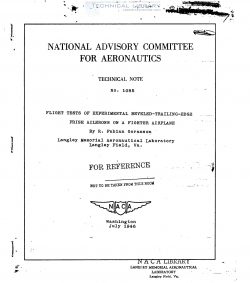naca-tn-1085
- Version
- 169 Downloads
- 1.70 MB File Size
- 1 File Count
- December 2, 2016 Create Date
- December 2, 2016 Last Updated
National Advisory Committee for Aeronautics, Technical Notes - Flight Tests of Experimental Beveled Trailing Edge Frise Ailerons on a Fighter Airplane

A pair of Frise ailerons was designed by the
Langley Memorial Aeronautical Laboratory of the NACA
to provide a close degree of balance and to maintain
a linear variation of aileron effectiveness with aileron
angle through a large deflection range. These ailerons
were intended for application to an experimental fighter
airplane. The wings_of this experimental airplane
consist of a 12.5-foot-span rectangular center section
with the wings of an existing production fighter air-
plane as the outen.panels. Flight tests of these ailerons
were conducted on the production airplane . A sketch
showing the wing plan.form of the experimental fighter
airplane as compared with the wing plan form of the test
airplane is shown as figure 1 and detail dimensions of
the test=airplane wing are shown in figure 2. It was
estimated that this increase in wing span of the experi-
mental airplane would decrease the aileron effectiveness
pb/2V to 71 percent of that available with the test
airplane.
An attempt was first made to-increase the rolling
effectiveness of the ailerons without modifying the outer
wing panel or the aileron support bracket so as to have
a value of pb/ZV of 0.07 on the experimental fighter
airplane with a 50-pound stick force at 292 miles per
hour. Modifications to the wing were allowed later,
however, and calculations were made to show the effects
of replacing the rounded wing tip by a square tip and
of extending the aileron outboard approximately 18 inches
without increasing the wing span.
Consideration of methods available to improve the
aileron rolling effectiveness without modifying the outer
wing panel indicated that the most expedient means was
to increase the aileron-deflection range from the range
of ~18° to 10°, used'on the test fighter airplane, to
a range of approximately $250, the deflection required
to obtain the desired effectiveness when a linear
variation of pb/EV with aileron angle is assumed
throughout the deflection range; _lncreasing the deflec-
tion range, however, was not merely a mechanical problem
because the existing FriSe aileron was effective to_an
up deflection of 18 only, at which deflection the
balance stalled. Furthermore, the increase in maximum
speed at which full deflection was required on the
experimental fighter airplane, together with the decrease
in stick- to-aileron mechanical advantage, would cause '
forces at full deflection to exceed the specified stick-
force limits by 300 to ADO percent if the existing ailerons
were used.
| File | Action |
|---|---|
| naca-tn-1085 Flight Tests of Experimental Beveled Trailing Edge Frise Ailerons on a Fighter Airplane.pdf | Download |

Comment On This Post